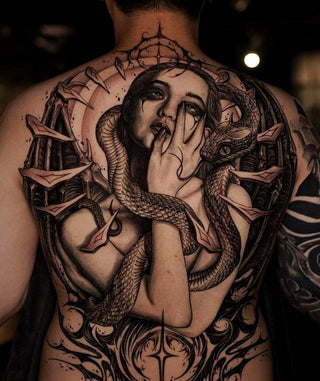Tattoos have been a form of self-expression and personal identity for centuries, and blackwork tattoos have recently gained popularity for their bold and striking designs. But what exactly are blackwork tattoos and what makes them unique? This guide will take you through the world of blackwork tattoos, covering their background, meaning, and popular designs.
Definition of Blackwork Tattoos
Blackwork tattoos, also known as black ink tattoos, feature bold, black patterns and designs. This style is recognized for its use of negative space and sharp lines, resulting in a minimalist and striking appearance. Unlike traditional tattoos that often use bright colors, blackwork tattoos are solely black, making them a favored choice for those seeking a simple yet elegant tattoo.
The History of Blackwork Tattoos
Blackwork tattoos have a rich history that spans centuries. The exact origin of blackwork tattoos is unknown, but they are thought to have originated in ancient civilizations such as the Polynesian and Maori cultures. These tattoos were used to identify individuals as part of a specific tribe or community and often symbolized spiritual beliefs or cultural rituals.
Recently, blackwork tattoos have become popular in the Western world due to contemporary tattoo artists who have expanded on traditional designs and created intricate new patterns. Despite their recent popularity, blackwork tattoos remain steeped in mystery and symbolism, making them a desired choice for those looking for a meaningful and timeless tattoo.
Significance of Blackwork Tattoos
One reason for the popularity of blackwork tattoos is their timeless and universal meaning. Black is often associated with depth, strength, and mystery, making it a favored choice for those seeking a meaningful and bold tattoo. In many cultures, black tattoos are also related to protection and spiritual beliefs, making them a popular choice for those searching for a spiritual connection through their tattoos.
Besides their universal meaning, blackwork tattoos can also hold personal significance for the individual. For instance, a blackwork tattoo can feature a symbol, such as a tribal design or a complex geometric pattern, that holds personal significance for the wearer. Regardless of the design, blackwork tattoos are a powerful means of self-expression and connection.
Popular Blackwork Tattoo Designs
Blackwork tattoos offer a vast range of design options, making them a sought-after choice for those seeking a unique and meaningful tattoo. Some of the most popular blackwork tattoo designs include:
Geometric patterns: Featuring symmetrical and intricate designs, geometric patterns are a favored choice for those seeking a minimalist and modern tattoo.
Tribal designs: Inspired by the tribal tattoos of ancient civilizations, tribal designs feature bold lines and intricate patterns that are rich in meaning and symbolism.
Floral designs: With delicate and intricate patterns, floral designs are a popular choice for those seeking a feminine and elegant tattoo.
Lettering: Featuring striking and bold lettering, lettering tattoos are a popular choice for those seeking a personal and meaningful tattoo.
Regardless of the design, blackwork tattoos are a powerful and significant form of self-expression and connection.
The Process of Getting a Blackwork Tattoo
Getting a blackwork tattoo is a personal and intimate experience, and it's important to understand the process before making the decision to get one. The process typically begins with selecting a design and finding a reputable and experienced tattoo artist who specializes in blackwork tattoos. The tattoo artist will then work with you to create a custom design that fits your style and personal preferences.
Once the design is finalized, the tattoo artist will clean and prepare the skin before beginning the tattoo process. The tattoo process typically takes several hours and may require multiple sessions, depending on the size and complexity of the design. During the tattoo process, the artist will carefully place the ink using a tattoo machine, filling in the design with bold, black lines.
Aftercare for Blackwork Tattoos
Taking care of a blackwork tattoo is an important part of the healing process, and it's important to follow the instructions provided by your tattoo artist to ensure that the tattoo heals properly and retains its bold, black color. Some of the steps involved in aftercare for blackwork tattoos include:
Cleaning the tattoo: It's important to clean the tattoo several times a day to prevent infection and promote healing.
Protecting the tattoo: The tattoo should be protected from sunlight and other sources of irritation to prevent fading and ensure that the bold, black lines are retained.
Moisturizing the tattoo: Moisturizing the tattoo can help to prevent cracking and itching, and can also help to promote healing.
By following these simple steps, you can ensure that your blackwork tattoo heals properly and retains its bold, black color for years to come.
Frequently Asked Questions (FAQs)
Are blackwork tattoos permanent?
Yes, blackwork tattoos are permanent, and the ink is designed to last for a lifetime.
Does it hurt to get a blackwork tattoo?
The pain of getting a blackwork tattoo varies depending on the individual and the location of the tattoo. Still, many people describe the sensation as similar to being poked with a needle.
How long does it take to heal from a blackwork tattoo?
The healing process for a blackwork tattoo typically takes several weeks, and during this time it's important to follow the aftercare instructions provided by your tattoo artist.
Can I get a blackwork tattoo removed?
Yes, blackwork tattoos can be removed, but the process can be time-consuming and expensive, and the results may not be complete.
Whether you're considering getting a blackwork tattoo, or simply interested in the style, this guide is a valuable resource for understanding this captivating and mysterious form of self-expression. So, if you're ready to explore the world of blackwork tattoos, start your journey today and uncover the secrets and meaning behind this powerful form of body art.


